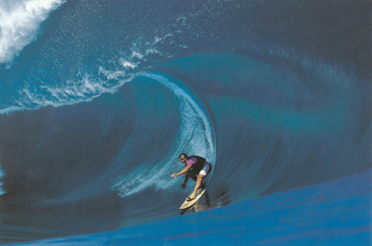|
Reviews of Recent Independent, Foreign, & Documentary Films in Theaters and DVD/Home Video
Directed by: Stacy Peralta. Produced by: Agi Orsi, Jane Kachmer & Stacy Peralta. Written by: Stacy Peralta & Sam George. Director of Photography: Peter Pilafian. Edited by: Paul Crowder. Released by: Sony Pictures Classics. Language: English Country of Origin: USA/France. 105 min. Rated: PG-13. With: Greg Noll, Jeff Clark & Laird Hamilton. DVD Features: Commentary by director Stacy Peralta & editor Paul Crowder. Commentary by writer Sam George & surfers Greg Noll, Jeff Clark & Laird Hamilton. “The Making of Riding Giants” documentary. Fuel TV’s Blue Carpet Special. Deleted scenes. Milan Records promo. Quicksilver promo. Previews.
With the 2004 box office thriving on controversy, Riding Giants is a welcome escape.
This may be the most harmless movie of the last few months. Stacy Peralta, capitalizing on the
energetic response to his skate-boarding-is-life documentary Dogtown and Z-Boys, crafts
Riding Giants in much the same way - Dogtown with surfboards.
The film portrays the early surf culture as a collection of young radicals looking for the next cool
thing. In one scene, a crowd gathers to watch a group of teens dress up like Nazis surf
through a storm drain for no apparent reason. Their love for entertaining reveals them to be the
original Jackass crew. But if there is a true narrative thread in Riding Giants, it is
the evolution of big wave riding. Peralta makes an interesting choice in his arrangement of
the film’s non-stop information. By presenting the film as unbendingly linear, every scene feels
as though you’re watching the most important moment in the history of the sport. But you soon
learn that there is always a more skilled surfer coming along, a better board to be made, and a
bigger wave to overcome. The first of these surf celebrities is Los Angeles hotdogger Greg
Noll. With a personality as big as his surfboard, it is easy to see why Noll’s popularity still
endures. Not only does his archival footage provide some of the film’s most impressive visuals,
but his interviews almost form a comedic reel of one-liners. Noll’s reactions to today’s biggest
riders range from empathy to embarrassment. And there is no bigger rider today (or
possibly ever), the film assures us, than pop culture icon Laird Hamilton. His surfing in Tahiti’s
“Millennium Wave” of August 2000 serves as the film’s climax. Riding
Giants is fluffy fun. Some audiences may be initially intimidated by their lack of surfing
knowledge, but a deficiency of wave smarts actually makes the film more enjoyable. To schooled
boarders, Riding Giants will probably seem like an extended music video of clips they’ve
seen hundreds of times (set to a predictable mix of old and new rock songs). To the rest of us, the
film is like watching a joyously self-indulgent pat on the back between the entire surfing
community. And without the unabashed indulgence, it just wouldn’t seem as cool. Michael Belkewitch
DVD Extras: Although at times the special features are repetitive, they are for the most part just as entertaining
as the movie. The deleted scenes give more personality to those being interviewed and more
thrills amongst the waves. “The Making of Riding Giants” slows down at times when Peralta
explains how he organized his interviews, but it illustrates how he took a small subculture, which
thrives on having a good time, and made it inclusive for a wide audience. The commentary by
Peralta and Crowder is nothing special, but it is amusing how they almost share the same
laid-back attitude as their fellow surfers do. The hidden gem of the special features is the
commentary by writer Sam George and surfers Greg Noll, Jeff Clark, and Laird Hamilton. Their
conversations shed more light on the technicalities of surfing, its history and dangers.
Noll provides an even more inside look, explaining how the underwater sequences were filmed (and how
he and his friends got drunk in Hawaii). James Schwartz
|
